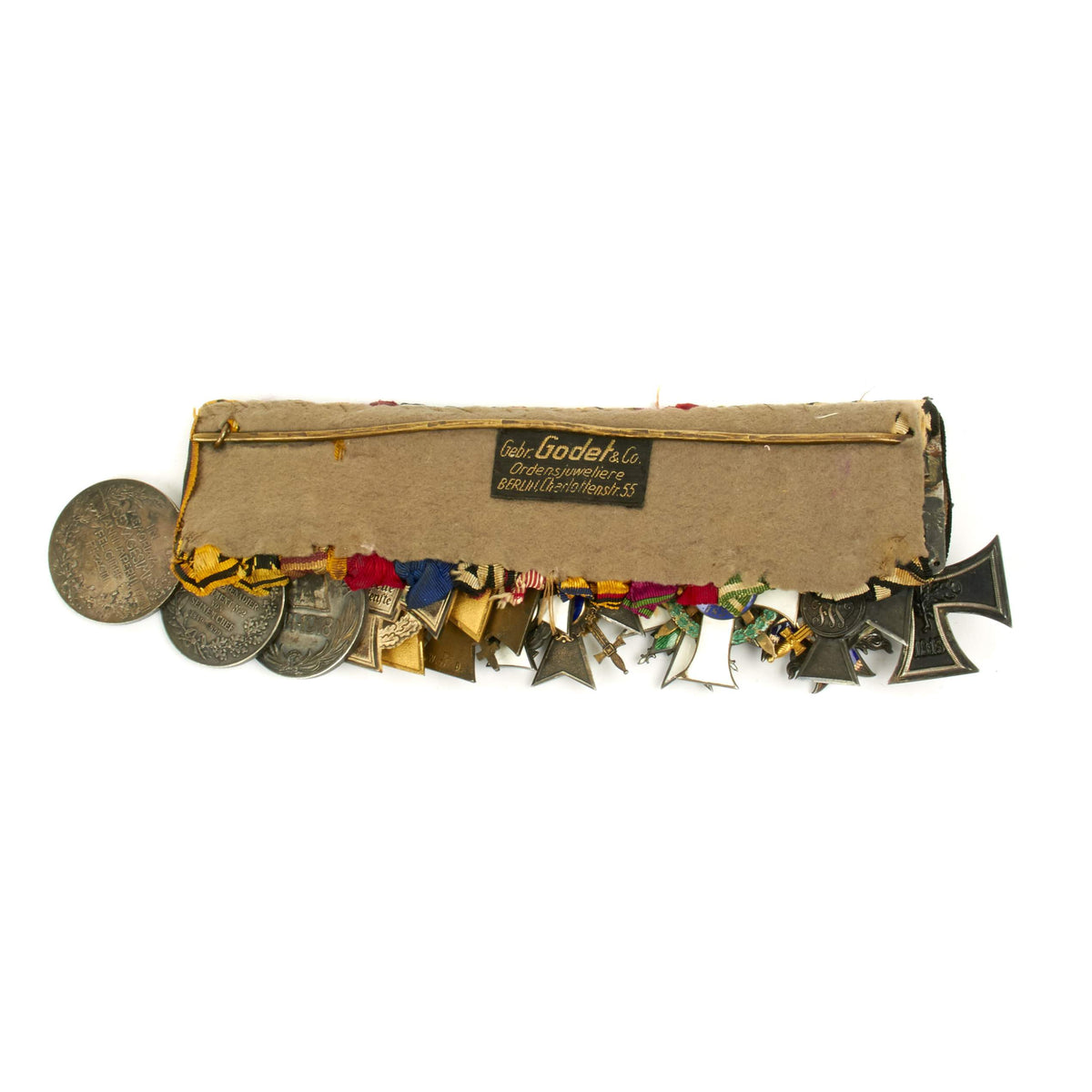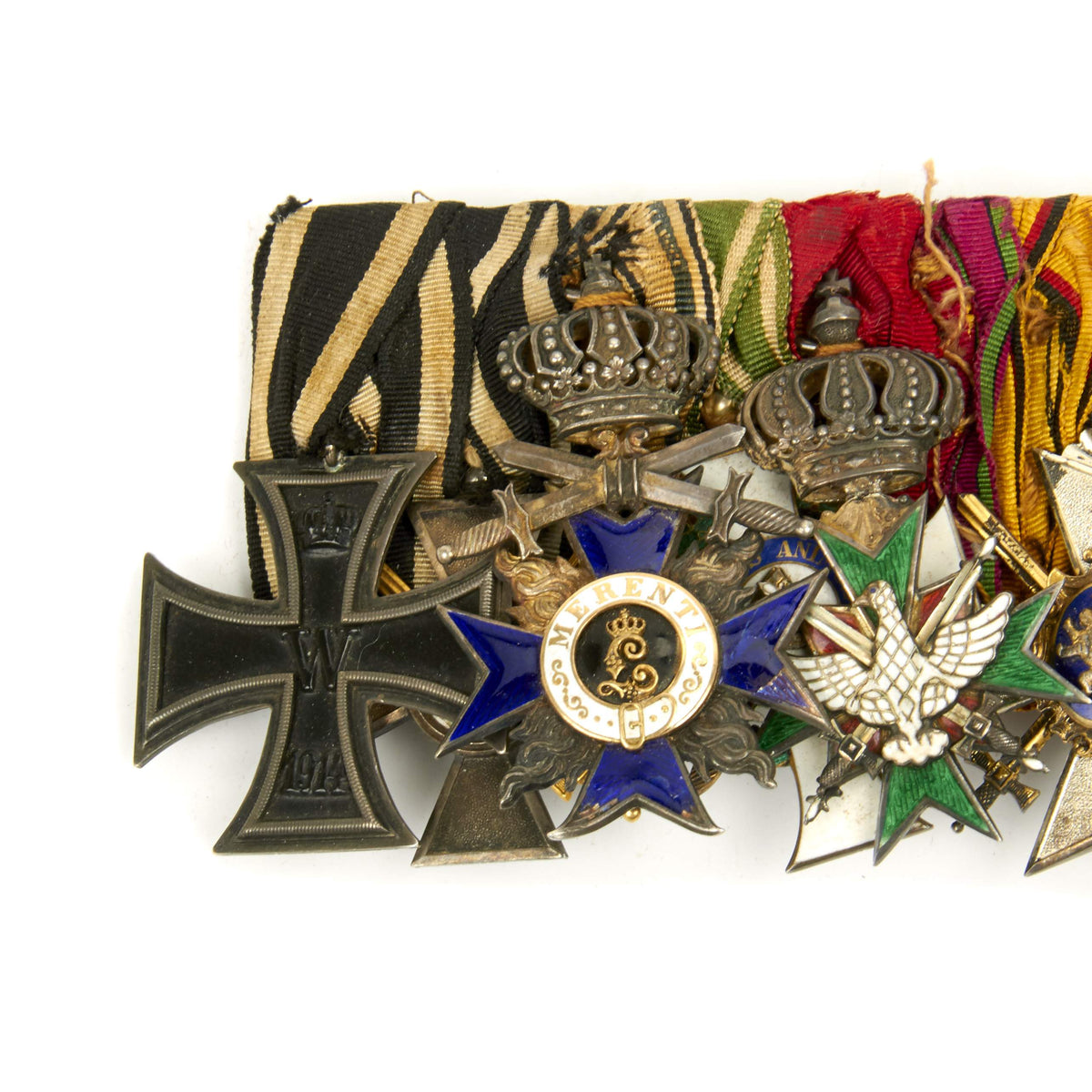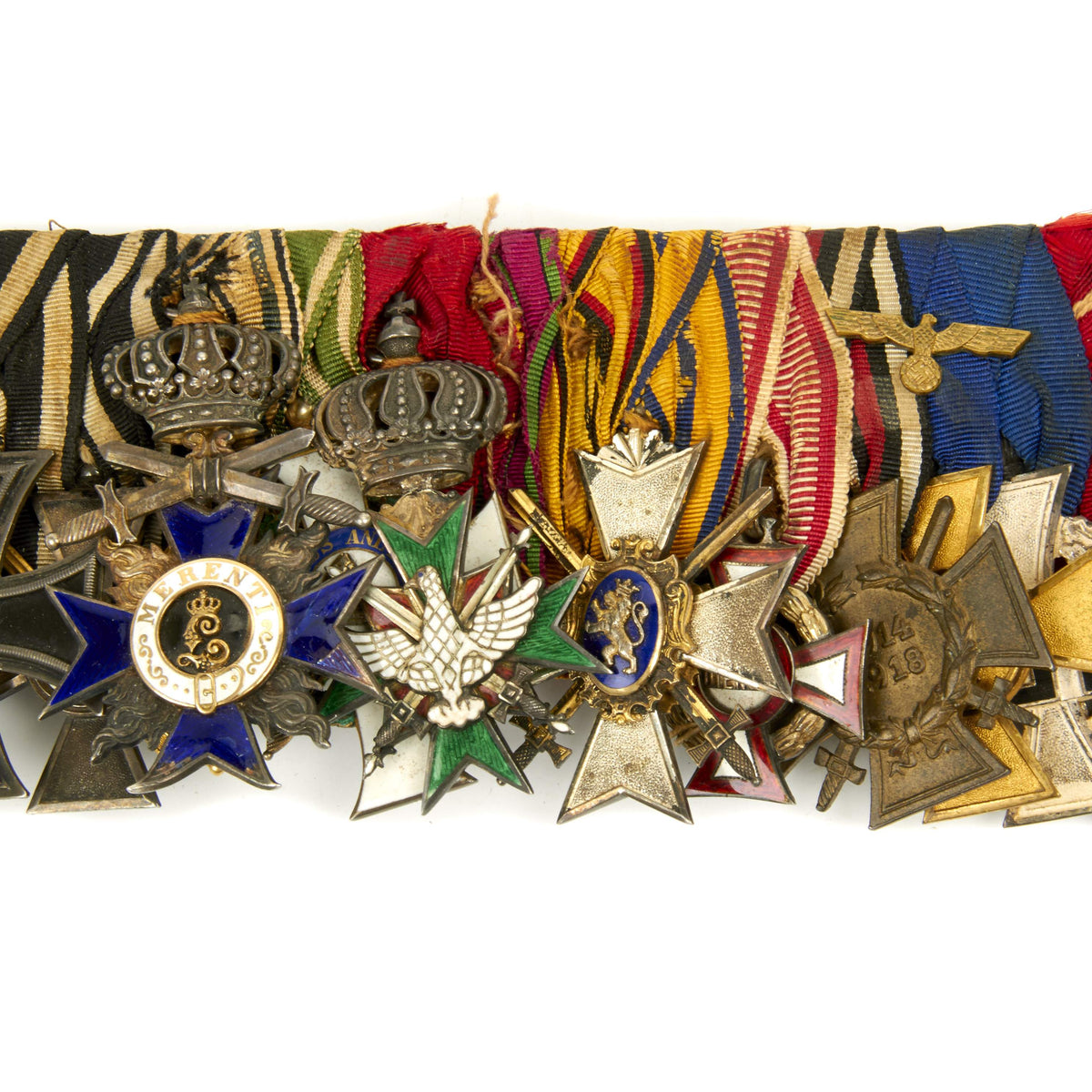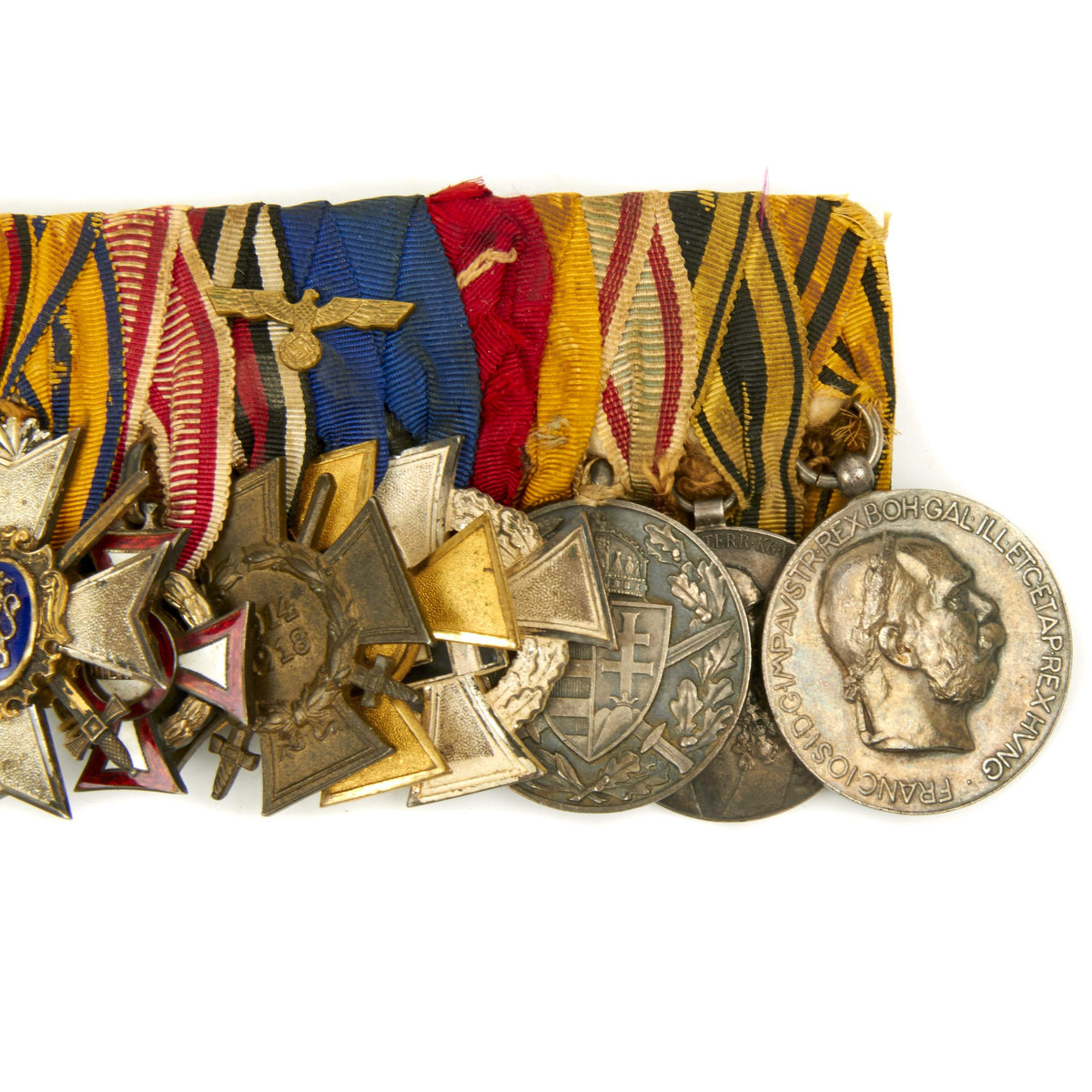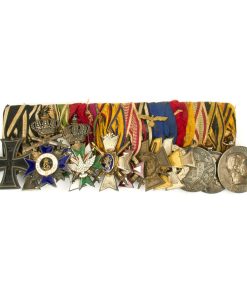Original German WWI WWII High Ranking Officer Medal Bar – 13 Medals Original Items
$ 1.795,00 $ 448,75
Original Item: One-of-a-kind. This is a truly incredible 100% genuine medal bar removed from the uniform of a fallen or captured high ranking German officer (Colonel or higher) during WWII and brought home by an American soldier as a war trophy.
This German officer was high ranking and very highly decorated. He served in World War One and then again in WW2. We do not know exactly who this medal bar belonged to but dedicated research should be able to narrow down or even identify the officer. If we had to guess, we think possibly Kurt von Hammerstein-Equord, Gotthard Heinrici, Walter von Unruh or Franz Halder, but more research is required. Also, while there are 13 medals present, there appear to be 16 ribbons on the bar. The three ribbons without medals are colored purple with green stripes( Saxe-Ernestine House Order?), plain red, and plain yellow (Wilhelm Centenary Medal 1897?).
The set of 13 medals is mounted on a backing board complete with pin back and makers label that reads Gebr. Godet & Co., Ordensjuweliere, Berlin, Charlottenstr. 55 and consists of the following medals:
WWI Iron Cross 2nd Class (Eisernes Kreuz 2. Klasse, or EKII)
WWI Bavarian Military Merit Order – Officers Cross with Crown and Swords
WWI Saxe Weimar Order of the White Falcon Knight Cross 2nd Class with Swords (Silver)
WWI Saxon Albert Order 1st Class Knight’s Cross with Swords
WWI Prussian Order of the Red Eagle 4th Class with Swords
WWI Princely Schwarzburg Honor Cross 3rd Class with Swords
WWI Austro-Hungary Military Merit Cross
WWI Honor Cross of the World War 1914/1918 (Hindenburg Cross) with Crossed Swords
WWII Wehrmacht 25 Year Long Service Award (Gold)
WWII 25 Year Civil Service Faithful Service Medal (2nd Class)
WWI Commemorative Medal Hungarian War Service 1914-1918
Emperor Franz Joseph 1898 Jubilee Royal Prussian Guard Grenadier Regiment No.2 Flag Medal
Emperor Franz Josef 60 Years of Reign 1848-1908 Commemorative Medal (Austro-Hungary)
Below is an explanation of each medal in detail:
Iron Cross 2nd Class:
Emperor Wilhelm II reauthorized the Iron Cross on 5 August 1914, at the start of World War I. During these three periods, the Iron Cross was an award of the Kingdom of Prussia, although given Prussia’s pre-eminent place in the German Empire formed in 1871 it tended to be treated as a generic German decoration. The 1813, 1870, and 1914 Iron Crosses had three grades.
The Iron Cross 1st Class and the Iron Cross 2nd Class were awarded without regard to rank. One had to possess the 2nd Class already in order to receive the 1st Class (though in some cases both could be awarded simultaneously). The egalitarian nature of this award contrasted with those of most other German states (and indeed of many other European monarchies), where military decorations were awarded based on the rank of the recipient. For example, Bavarian officers received various grades of that Kingdom’s Military Merit Order (Militär-Verdienstorden), while enlisted men received various grades of the Military Merit Cross (Militär-Verdienstkreuz). Prussia did have other orders and medals which it awarded on the basis of rank, and even though the Iron Cross was intended to be awarded without regard to rank, officers and NCOs were more likely to receive it than junior enlisted soldiers.
Bavarian Military Merit Order
The Bavarian Military Merit Order (Militär-Verdienstorden) was established on July 19, 1866 by King Ludwig II of Bavaria. It was the kingdom’s main decoration for bravery and military merit for officers and higher-ranking officials. Civilians acting in support of the army were also made eligible for the decoration. The Military Merit Order ranked below the Military Order of Max Joseph (Militär-Max-Joseph-Orden), which was Bavaria’s highest military honor for officers (and conferred a patent of non-hereditary nobility on officers who were not already nobles).
The design of the order was a Maltese cross of blue enamel with a center medallion. Between the arms of most classes (and all classes after 1905) were golden flames (silver flames for the 4th Class after the 1905 revisions of the order). The obverse of the center medallion had a gold crowned “L” cipher (for the founder King Ludwig II) on the black-enameled center and the word “MERENTI” on a ring of white enamel edged in gold (later silver-gilt). The reverse had a gold Bavarian lion on black enamel with the date of founding, “1866”, on the white-enameled ring (the Officer’s Cross, a class created in 1900, had a plain flat reverse). Most of the various classes of the order were of different sizes and worn differently, as sash badges over the shoulder, as neck badges, or as breast badges suspended from a ribbon. The Officer’s Cross was a pinback cross worn on the lower left chest, as were the breast stars associated with various classes. Officer’s Cross (Offizierskreuz) – Pinback cross worn on the lower left chest; the cross had an elongated lower arm. Officer’s Cross with Swords (Offizierskreuz mit Schwertern) – was awarded to Colonels and some lieutenant colonels.
Grand Duchy of Saxe-Weimar-Eisenach: Order of the White Falcon
Instituted: 2 August 1732 by Duke Ernst-August I. Awarded for civil and military merit. An award ‘with swords’ made for bravery and merit on the field of battle from 22 September 1870. The grades of the White Falcon were Grand Cross, Commander 1st Class (Komturkreuz 1. Klasse), Commander (Komturkreuz), Knight 1st Class (Ritterkreuz 1. Abteilung), and Knight 2nd Class (Ritterkreuz 2. Abteilung), with the Merit Cross (Verdienstkreuz) affiliated with the order.
A Saxon Albert Order; 1st Class Knight’s Cross with Swords
The Albert Order (German: Albrechts-Orden) was created 31 December 1850 by King Frederick Augustus II of Saxony to commemorate Albert III, Duke of Saxony (known as Albert the Bold) and was to be awarded to anyone who had served the state well, for civil virtue, science and art. The design was a Christian cross with a bust of Albert the Bold at the centre. In 1875, however, it was discovered the bust was in fact the wrong Albert, Albert the Perennial, and the correct image was substituted and used thereafter.
The grade structure of the Albert Order changed several times. At first, there were five classes: Grand Cross (Großkreuz), Commander’s Cross 1st Class (Komturkreuz I), Commander’s Cross 2nd Class (Komturkreuz II), Knight’s Cross (Ritterkreuz) and Small Cross (Kleinkreuz). These provided the basis for a series of changes over the following forty years. On 18 March 1858, the Small Cross was renamed as the Honour Cross (Ehrenkreuz) and a sixth class was established with a gold and silver Merit Medal (Verdienstmedaille). A Merit Cross (Verdienstkreuz) with Swords was added on 29 October 1866 and this was extended on 9 December 1870 with the Merit Cross with Swords on Ring.
The medals were abolished on 2 February 1876 and the Knights Cross was split into two classes. On 30 April 1884, a gold Great Cross was added and on 11 June 1890, the Officer’s Cross was inserted into the Order between the Knight’s Cross 1st Class and the Commander’s Cross 2nd Class. So, at its abolition in 1918, the Order was structured thus:
Gold Grand Cross
Grand Cross (Großkreuz)
Commander’s Cross 1st Class (Komturkreuz I)
Commander’s Cross (Komturkreuz II)
Officer’s Cross (Offizierskreuz)
Knight’s Cross 1st Class (Ritterkreuz I)
Knight’s Cross 2nd Class (Ritterkreuz II)
Honour Cross (Ehrenkreuz)
Merit Cross (Verdienstkreuz) with Swords
An award of Swords indicated a recipient’s bravery in wartime. If, however, a recipient was subsequently awarded a higher grade in the Order, he could lose the bravery distinction attached to the superseded grade (regulations only allowed the display of the insignia of the highest awarded grade). This anomaly was solved in 1906 by allowing the addition of Swords by replacement of insignia. A recipient, however, had to pay the cost of replacement and this appears to have inhibited the numbers of such replacements.
Prussian Order of the Red Eagle 4th Class with Swords
The Order of the Red Eagle (German: Roter Adlerorden) was an order of chivalry of the Kingdom of Prussia. It was awarded to both military personnel and civilians, to recognize valor in combat, excellence in military leadership, long and faithful service to the kingdom, or other achievements. As with most German (and most other European) orders, the Order of the Red Eagle could only be awarded to commissioned officers or civilians of approximately equivalent status. However, there was a medal of the order, which could be awarded to non-commissioned officers and enlisted men, lower ranking civil servants and other civilians.
The predecessor to Order of the Red Eagle was founded on November 17, 1705, by the Margrave Georg Wilhelm of Brandenburg-Bayreuth as the Ordre de la Sincerité. This soon fell into disuse but was revived in 1712 in Brandenburg-Bayreuth and again in 1734 in Brandenburg-Ansbach, where it first received the name “Order of the Brandenburg Red Eagle”. The statutes were changed in 1777 and the Order named therein as the “Order of the Red Eagle”. The Order was conferred in one class, limited to fifty knights.
The Kingdom of Prussia absorbed both Brandenburg-Bayreuth and Brandenburg-Ansbach in January, 1792, and on June 12, 1792, King Frederick William II again revived the order as a Prussian royal order. After the Order of the Black Eagle, the Red Eagle was the second highest order of the kingdom in order of precedence.
In 1810, King Frederick William III revised the statutes of the Order, expanding it into three classes. In 1830, a breast star was authorized for the Second Class and the First Class General Honor Decoration became the Fourth Class of the Order. The statutes were further revised in 1861, and a Grand Cross was established as the highest class of the Order. By change to the statutes of the Order of the Black Eagle, every member of that order was automatically invested with the new Grand Cross of the Order of the Red Eagle, as well as with the Order of the Prussian Crown. By 1918, an affiliated soldier’s medal had been made available to commoners and enlisted men.
The monarchy collapsed on November 9, 1918. Though Wilhelm II formally abdicated his personal claims to the throne on November 28, 1918, he admonished his former subjects to “render assistance to those in actual power” until the “re-establishment of order in the German Empire” (1923 Source Records of the Great War, Vol. VI, edited by Charles F. Horne). A new German constitution was signed into law, August 11, 1919, effectually putting a legal end to the monarchy. All orders and decorations formally conferred by the monarchy ceased to exist, but recipients of the Order of the Red Eagle continued to wear it with their other decorations during the eras of the Weimar Republic, the Third Reich, and the restored republic.
4th Class – non-enameled cross pattée badge worn on a ribbon on the left chest; available to company grade officers. All classes but the Medal of the Red Eagle Order could be awarded with swords for distinction in wartime. The swords passed through the arms of the cross behind the center medallion.
Princely Schwarzburg Honor Cross
Fürst Friedrich Günther of Schwarzburg-Rudolstadt founded his house order on May 20, 1853. On June 28, 1857 he signed a convention with his cousin Fürst Günther Friedrich Carl II of Schwarzburg-Sondershausen whereby the latter also adopted this order, which was then designated the Princely Schwarzburg Honor Cross and was jointly issued by the two states. The decoration was identical for both states, with only the cipher on the reverse distinguishing the two – an “FG” for Schwarzburg-Rudolstadt and a “GFC” for Schwarzburg-Sondershausen.
The Honor Cross originally came in three classes. A 4th Class was added in 1873. The 1st and 2nd Classes can be distinguished from the 3rd and 4th by having enameled arms (the 1st Class, a neck badge, is also larger than the others, and there is also a 1st Class with Crown). The 3rd and 4th Class has silver arms, with the 3rd having an enamel center medallion while the 4th is all silver. Affiliated with the order were gold and silver honor medals (Ehrenmedaillen).
Swords were authorized during the Franco-Prussian War for bravery or military merit in the face of the enemy. Schwarzburg-Rudolstadt adopted this distinction on October 21, 1870 and Schwarzburg-Sondershausen followed suit on April 14, 1871. Fürst Günther Victor, now ruling both principalities, revived this distinction on August 21, 1914, additionally authorizing swords for the 4th Class (which did not exist when the 1870 and 1871 statutes were adopted). On January 19, 1915, another distinction was created – an Oak Brooch (Eichenbruch) device to indicate merit in service of the war effort not involving action before the enemy.
Austro-Hungary Military Merit Cross
The Military Merit Cross (German: Militärverdienstkreuz, Hungarian: Katonai Érdemkereszt, Croatian: Vojni kri za zasluge) was a decoration of the Empire of Austria and, after the establishment of the Dual Monarchy in 1867, the Empire of Austria-Hungary. It was first established on October 22, 1849 and underwent several revisions to its design and award criteria over the years of its existence. It became obsolete in 1918 with the dissolution of the Austro-Hungarian Empire.
The Military Merit Cross is a cross pattée of white enamel edged in red enamel, with a center medallion also of white enamel edged in red enamel, on which the word “VERDIENST” (merit) appears, broken into “VER” and “DIENST” to fit the center. The War Decoration is a green enamel wreath of laurel leaves between the arms of the cross.
The 3rd Class is suspended from a trifold ribbon. The ribbon is that of the Austrian Bravery Medal, a “laddered” pattern of red stripes with white between the “rungs” and a white border (this ribbon was also used for wartime awards of a number of other Austro-Hungarian decorations). The cross is approximately 30-mm in width, with the arms broadening to a width of 15-mm. The center medallion is approximately 13-mm in diameter. The War Decoration wreath, which during World War I was gilt rather than green, is 3-mm wide.
Hindenburg Cross with Crossed Swords (for combat)
The Honor Cross of the World War 1914/1918 (German: Das Ehrenkreuz des Weltkriegs 1914/1918), commonly, but incorrectly, known as the Hindenburg Cross was established by Field Marshal Paul von Hindenburg, President of the German Republic, by an order dated 13 July 1934, to commemorate the distinguished deeds of the German people during the First World War. This was Germany’s first official service medal for soldiers of Imperial Germany who had taken part in the war, and where they had since died it was also awarded to their surviving next-of-kin. Shortly after its issuance, the government of NSDAP Germany declared the award as the only official service decoration of the First World War and further forbid the continued wearing of German Free Corps awards on any military or paramilitary uniform of a state or NSDAP Party organization.
WWII Wehrmacht 25 Year Long Service Award (Gold)
The Wehrmacht Long Service Award (German: Wehrmacht-Dienstauszeichnung) was a military service decoration of NSDAP Germany issued for satisfactory completion of a number of years in military service. On 16 March, 1936, Adolf AH ordered the institution of service awards for the first four classes. Thereafter, on 10 March, 1939, the 40 years service award was introduced.
Each branch of the Wehrmacht (army, navy, and air force) maintained their own version of the Long Service Award and the decoration was issued for four years (fourth class), 12 years (third class), 18 years (second class), 25 years (first class), and 40 years (1939 special class).
The Long Service Award was retroactive throughout a service member’s career, encompassing Reichswehr service as well as service dating during and before World War I. As such, there were a handful of 40 year awards presented, even though the NSDAP era only lasted 12 years (1933-1945).
WWII 25 Year Civil Service Faithful Service Medal
The Civil Service Faithful Service Medal (Treudienst-Ehrenzeichen für Beamte Angestellte und Arbeiter im öffentlichen Dienst) was a NSDAP Germany medal of honor that was founded on 30 January 1938, in two grades, to reward civilians in the employ of the German public services for long and faithful service. All officials, employees, and laborers at any level of the public service (local, regional or national) who complete 25 or 40 years service were eligible.
The second class award was for 25 years of service was a silver cross, with a silver wreath and a black enameled swas in the center of the cross.
The first class award was for 40 years of service was a gold cross, with a gold wreath and a black enameled swas in the center of the cross.
The reverse of both classes was stamped with ‘Für treue Dienste’ (For faithful Services). The ribbon for the medal is cornflower blue.
WWI Commemorative Medal Hungarian War Service 1914-1918
WWI Commemorative medal, War Service 1914-1918 (Hungary) Reads “Pro Deo et Patria on its back and it was awarded to the war veterans of 1914-1918, it would be from Hungary as Austro – Hungary ceased to exist.
Emperor Franz Joseph 1898 Jubilee Royal Prussian Guard Grenadier Regiment No.2 Flag Medal
In 1898 there were also gold flag medals presented to regiments for which the Emperor was the Proprietor. One such regiment was the Royal Prussian Guard Grenadier Regiment No.2. Unlike the other flag medals this one was embellished with an imperial crown that was placed on the ribbon (missing from this example).
Emperor Franz Josef 60 Years of Reign 1848-1908 Commemorative Medal (Austro-Hungary)
Franz Josef 60 Years of Reign 1848-1908 commemorative Medal (Austro-Hungary). Given during or after 1908 to commemorate 60 years of rule by Franz Josef I of Austro-Hungary.
Fast Shipping with Professional Packaging
Thanks to our longstanding association with UPS FedEx DHL, and other major international carriers, we are able to provide a range of shipping options. Our warehouse staff is expertly trained and will wrap your products according to our exact and precise specifications. Prior to shipping, your goods will be thoroughly examined and securely secured. We ship to thousands clients each day across multiple countries. This shows how we're dedicated to be the largest retailer on the internet. Warehouses and distribution centres can be located throughout Europe as well as the USA.
Note: Orders with more than one item will be assigned a processing date depending on the item.
Before shipping before shipping, we'll conduct a thorough inspection of the items you have ordered. Today, the majority of orders will be delivered within 48 hours. The delivery time will be between 3-7 days.
Returns
The stock is dynamic and we cannot completely manage it because multiple stakeholders are involved, including our factory and warehouse. So the actual stock may alter at any time. It's possible that you may not receive your order once the order has been made.
Our policy is valid for a period of 30 days. If you don't receive the product within 30 days, we are not able to issue a refund or an exchange.
You can only return an item if it is unused and in the same state as the day you received it. You must have the item in its original packaging.
Related products
Uncategorized
Australian WWII Owen MK1 Machine Carbine SMG Custom Fabricated Replica with Sling Original Items
Uncategorized
Uncategorized
Uncategorized
Armoured Fighting Vehicles of the World: AFVs of World War One (Hardcover Book) New Made Items
Uncategorized
Angolan Rebel 1970s era 60mm Inert Display Mortar from Angolan Civil War Original Items
Uncategorized
Uncategorized
Armored Burgonet Helmet & Polearm from Scottish Castle Leith Hall Circa 1700 Original Items
Uncategorized
Uncategorized
Uncategorized
Uncategorized
Uncategorized
Uncategorized
Uncategorized
Uncategorized
Uncategorized

